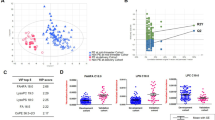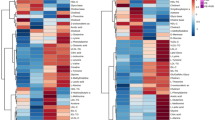Abstract
Introduction
Poor gestational outcomes due to placental insufficiency can have lifelong consequences for mother and child.
Objective
There is a need for better methods of diagnosis, and elemental metabolomics may provide a means to determine the risk of gestational disorders.
Methods
This study used blood plasma samples collected at 36 weeks’ gestation from women who later developed preeclampsia (n = 38), or small-for-gestational age babies (n = 91), along with matched controls (n = 193). Multi-element analysis was conducted by inductively coupled plasma mass spectrometer (ICP-MS), allowing simultaneous measurement of 28 elements.
Results
Women who later developed PE, exhibited significantly increased concentrations of K, Rb and Ba. For SGA pregnancies, there was a significant increase in Cu and a decrease in As concentrations. Despite significant differences in single elements, the elemental profile of groups indicated no clustering of control, PE, or SGA samples. Positive predicative values correctly identified approximately 60% of SGA and 70% of PE samples.
Conclusion
This is the first-time elemental metabolomics has been used to predict SGA and PE at 36 weeks. Though significant changes were identified, routine clinical use may be limited but may contribute to a multi marker test. Future analysis should include other biomarkers, metabolic data or clinical measurements made throughout gestation.




Similar content being viewed by others
References
Barnett, M. P., Chiang, V. S., Milan, A. M., Pundir, S., Walmsley, T. A., Grant, S., Markworth, J. F., Quek, S.-Y., George, P. M., & Cameron-Smith, D. (2018). Plasma elemental responses to red meat ingestion in healthy young males and the effect of cooking method. European Journal of Nutrition, 58, 1–8.
Beck, S., Wojdyla, D., Say, L., Betran, A. P., Merialdi, M., Requejo, J. H., Rubens, C., Menon, R., & Van Look, P. F. (2010). The worldwide incidence of preterm birth: A systematic review of maternal mortality and morbidity. Bulletin of the World Health Organization, 88, 31–38.
Bravo, I. D. B., Castro, R. S., Riquelme, N. L., Díaz, C. T., & Goyenaga, D. A. (2007). Optimization of the trace element determination by ICP-MS in human blood serum. Journal of Trace Elements in Medicine and Biology, 21, 14–17.
Chong, J., Wishart, D. S., & Xia, J. (2019). Using MetaboAnalyst 4.0 for comprehensive and integrative metabolomics data analysis. Current Protocols in Bioinformatics, 68(1), e86.
Crump, C., Sundquist, K., & Sundquist, J. (2016). Adult outcomes of preterm birth. Preventive Medicine, 91, 400–401.
Fatihoglu, E., & Aydin, S. (2020). Diagnosing small for gestational age during second trimester routine screening: Early sonographic clues. Taiwanese Journal of Obstetrics and Gynecology, 59(2), 287–292.
Gajewska, K., Błażewicz, A., Laskowska, M., Niziński, P., Dymara-Konopka, W., & Komsta, Ł. (2020). Chemical elements and preeclampsia-An overview of current problems, challenges and significance of recent research. Journal of Trace Elements in Medicine and Biology, 59, 126468.
Gluckman, P., Hanson, M., Seng, C. Y., & Bardsley, A. (2015). Nutrition and lifestyle for pregnancy and breastfeeding. Oxford University Press.
Hofstee, P., McKeating, D. R., Perkins, A. V., & Cuffe, J. S. (2018). Placental adaptations to micronutrient dysregulation in the programming of chronic disease. Clinical and Experimental Pharmacology and Physiology, 45, 871–884.
Liang, C.-M., Wu, X.-Y., Huang, K., Yan, S.-Q., Li, Z.-J., Xia, X., Pan, W.-J., Sheng, J., Tao, Y.-R., & Xiang, H.-Y. (2019). Trace element profiles in pregnant women’s sera and umbilical cord sera and influencing factors: Repeated measurements. Chemosphere, 218, 869–878.
Liu, T., Zhang, M., Guallar, E., Wang, G., Hong, X., Wang, X., & Mueller, N. T. (2019). Trace minerals, heavy metals, and preeclampsia: Findings from the Boston Birth Cohort. Journal of the American Heart Association, 8(16), e012436.
McAlpine, J. M., McKeating, D. R., Vincze, L., Vanderlelie, J. J., & Perkins, A. V. (2019). Essential mineral intake during pregnancy and its association with maternal health and birth outcomes in South East Queensland, Australia. Nutrition and Metabolic Insights, 12, 1178638819879444.
McKeating, D., Fisher, J., & Perkins, A. (2019a). Elemental metabolomics and pregnancy outcomes. Nutrients, 11(1), 73.
McKeating, D. R., Fisher, J. J., Zhang, P., Bennett, W. W., & Perkins, A. V. (2019b). Elemental metabolomics in human cord blood: Method validation and trace element quantification. Journal of Trace Elements in Medicine and Biology, 59, 126419.
McKeating, D. R., Fisher, J. J., Zhang, P., Bennett, W. W., & Perkins, A. V. (2020). Elemental metabolomics in human cord blood: Method validation and trace element quantification. Journal of Trace Elements in Medicine and Biology, 59, 126419.
McNamara, H., Hutcheon, J. A., Platt, R. W., Benjamin, A., & Kramer, M. S. (2014). Risk factors for high and low placental weight. Paediatric and Perinatal Epidemiology, 28(2), 97–105.
Morris, C. D., Jacobson, S.-L., Anand, R., Ewell, M. G., Hauth, J. C., Curet, L. B., Catalano, P. M., Sibai, B. M., & Levine, R. J. (2001). Nutrient intake and hypertensive disorders of pregnancy: Evidence from a large prospective cohort. American Journal of Obstetrics & Gynecology, 184(4), 643–651.
Paglia, G., Miedico, O., Cristofano, A., Vitale, M., Angiolillo, A., Chiaravalle, A. E., Corso, G., & Di Costanzo, A. (2016). Distinctive pattern of serum elements during the progression of Alzheimer’s disease. Scientific Reports, 6, 1–12.
Patnaik, P. (2003). Handbook of inorganic chemicals. McGraw-Hill.
Relman, A. S. (1956). The physiological behavior of rubidium and cesium in relation to that of potassium. The Yale Journal of Biology and Medicine, 29(3), 248.
Shah, P. S., & Knowledge Synthesis Group on Determinants of Preterm/Low Birthweight Births. (2010). Births, Paternal factors and low birthweight, preterm, and small for gestational age births: a systematic review. American Journal of Obstetrics and Gynecology, 202(2), 103–123.
Snart, C. J. P., Threapleton, D. E., Keeble, C., Taylor, E., Waiblinger, D., Reid, S., & Hardie, L. J. (2020). Maternal iodine status, intrauterine growth, birth outcomes and congenital anomalies in a UK birth cohort. BMC Medicine, 18(1), 1–11.
Speich, M., Bousquet, B., Auget, J.-L., Gelot, S., & Laborde, O. (1992). Association between magnesium, calcium, phosphorus, copper, and zinc in umbilical cord plasma and erythrocytes, and the gestational age and growth variables of full-term newborns. Clinical Chemistry, 38(1), 141–143.
Tu’uhevaha, J., MacDonald, T. M., Cannon, P., Nguyen, T.-V., Hiscock, R. J., Haan, N., Myers, J. E., Hastie, R., Dane, K. M., & Middleton, A. L. (2020). Circulating SPINT1 is a biomarker of pregnancies with poor placental function and fetal growth restriction. Nature Communications, 11(1), 1–10.
Vahter, M. (2009). Effects of arsenic on maternal and fetal health. Annual Review of Nutrition, 29, 381–399.
Wasowicz, W., Wolkanin, P., Bednarski, M., Gromadzinska, J., Sklodowska, M., & Grzybowska, K. (1993). Plasma trace element (Se, Zn, Cu) concentrations in maternal and umbilical cord blood in Poland. Biological Trace Element Research, 38(2), 205–215.
Wolak, T., Shoham-Vardi, I., Sergienko, R., & Sheiner, E. (2016). High potassium level during pregnancy is associated with future cardiovascular morbidity. The Journal of Maternal-Fetal & Neonatal Medicine, 29(6), 1021–1024.
Yılmaz, Z. V., Akkaş, E., Türkmen, G. G., Kara, Ö., Yücel, A., & Uygur, D. (2017). Dietary sodium and potassium intake were associated with hypertension, kidney damage and adverse perinatal outcome in pregnant women with preeclampsia. Hypertension in Pregnancy, 36(1), 77–83.
Zhang, P., Georgiou, C. A., & Brusic, V. (2017). Elemental metabolomics. Briefings in Bioinformatics, 19, 524–536.
Acknowledgements
The authors would like to acknowledge the financial support of the Norman Beisher Medical Research Foundation (NBMRF), and the Allen Foundation. The authors would also like to thank all the participants, and researchers who contributed to the Fetal Longitudinal Assessment of Growth cohort.
Funding
This research was funded by the Norman Beisher Medical Research Foundation (NBMRF), and the Allen Foundation.
Author information
Authors and Affiliations
Contributions
Conceptualization, DRM, JJF, TM, SW, ST, WWB, TJK-L, and AVP; methodology, DRM, TM, SW, ST, WWB, and TJK-L; formal analysis, DRM; data curation, TM; writing—original draft preparation, DRM; writing—review and editing, JJF, ST, TJK-L, and AVP; supervision, TJK-L, and AVP; project administration, TM, SW, ST, TJK-L, and AVP; funding acquisition, TJK-L, and AVP. All authors have read and agreed to the published version of the manuscript.” Please turn to the CRediT taxonomy for the term explanation. Authorship must be limited to those who have contributed substantially to the work reported.
Corresponding author
Ethics declarations
Conflict of interest
The authors declare no conflict of interest.
Institutional Review Board Statement
FLAG study ran from 2015 through to 2016 and was approved by the Mercy Health Research Ethics Committee, Ethics Approval Number R14/12.
Informed consent
Informed consent was obtained from all subjects involved in the study.
Additional information
Publisher's Note
Springer Nature remains neutral with regard to jurisdictional claims in published maps and institutional affiliations.
Rights and permissions
About this article
Cite this article
McKeating, D.R., Fisher, J.J., MacDonald, T. et al. Circulating trace elements for the prediction of preeclampsia and small for gestational age babies. Metabolomics 17, 90 (2021). https://doi.org/10.1007/s11306-021-01840-0
Received:
Accepted:
Published:
DOI: https://doi.org/10.1007/s11306-021-01840-0




